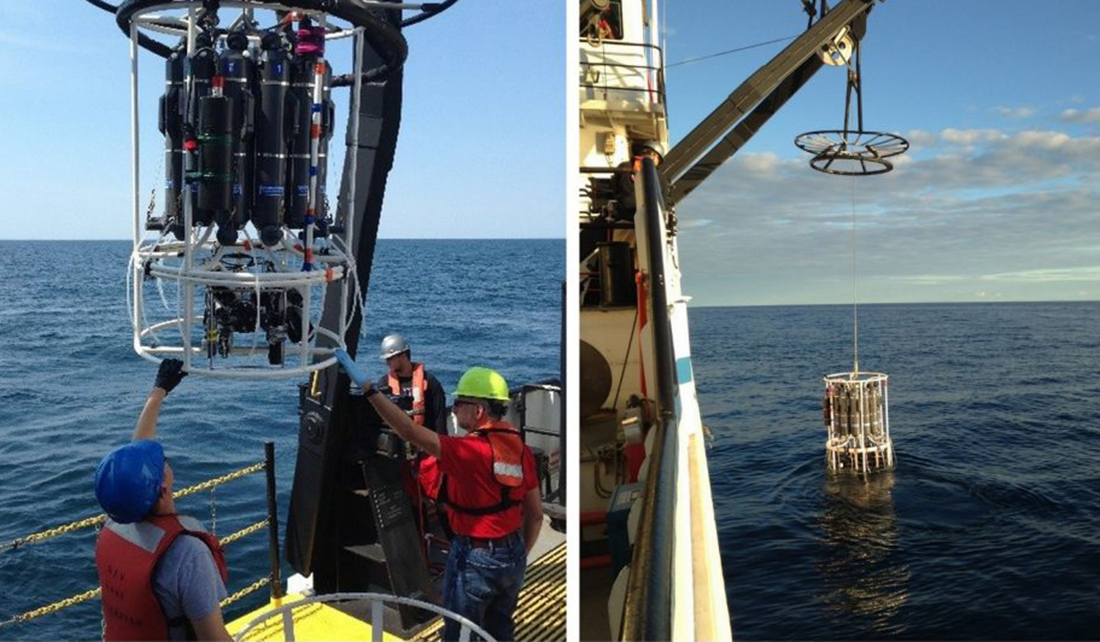
This post, written by Kathryn Meyer and Todd Nettesheim, U.S. Environmental Protection Agency, originally appeared on the International Joint Commission website.
Out on the Great Lakes, the U.S. Environmental Protection Agency’s Lake Guardian research vessel is not your typical ship.
It has the usual pilot house, cabin rooms, and galley, but this 180-foot research vessel has a few extra special features. Those include three onboard laboratories; a Rosette water sampler for measuring conductivity, temperature and depth; and multiple devices for sediment collection. These additions allow researchers to analyze water, sediment, and biological data while the Lake Guardian travels across the Great Lakes.
Also special is the collaborative group of scientists, from the U.S. EPA’s Great Lakes National Program Office (GLNPO) and other government agencies and universities, working onboard to collect and analyze samples to monitor the health of the Great Lakes. The overarching goal of the science performed onboard is to understand the chemical, physical, and biological changes in the lakes to help inform fishery and water quality managers.
The Lake Guardian is a floating laboratory essential to many Great Lakes long-term monitoring programs, with about 25 years of data collected since its first voyage on the lakes in 1991. Starting out on Lake Michigan, the ship samples the lakes twice a year as part of the routine spring and summer surveys. The ship weaves across each lake to reach specified sampling stations. Onboard, scientists and crew work around the clock to ensure that each station is sampled as the ship passes by Great Lakes icons including the Mackinac Bridge, Welland Canal, Soo Locks, and Isle Royale.
Other parts of the Great Lakes are sampled by the EPA’s research vessel Mudpuppy II, a 33-foot shallow vessel designed for studies to determine the nature and extent of contaminated sediment in Great Lakes nearshore areas.
In August, EPA scientists from GLNPO collaborated with scientists from Buffalo State, Cornell University, University of Chicago, and University of Minnesota-Duluth to complete the Lake Guardian’s 2016 Summer Survey.
The survey consists of 97 stations where scientists collect water, phytoplankton, zooplankton, benthos (invertebrates that live on the bottom of the lakes), and sediment samples. Each station starts with the Rosette sampler plunging into the water to retrieve water samples at different depths on the starboard side, while on the aft deck plankton nets are cast into the water.
On some stations, a ponar sampler also is dropped to the bottom of the lake to scoop up sediment and collect benthos. Once the samples are back onboard, they are either immediately analyzed in one of the ship’s labs or preserved for analysis on land. The water samples help to track nutrient concentrations among other water chemistry parameters. The biological samples help us track changes and better understand the lower food web in the lakes.
The month of sample collection and analysis, knowledge-sharing and comradery onboard the Lake Guardian highlights the shared commitment to protect the health of the Great Lakes.
For example, GLNPO began monitoring nutrient concentrations in Lake Erie in 1983 to assess the effectiveness of phosphorus load reduction programs initiated by the 1983 phosphorus load supplement to the Great Lakes Water Quality Agreement (GLWQA). Data showed that the lake responded to the phosphorus load reductions and in-lake total phosphorus concentrations approached targets in the late 1980s. Our data also documented the re-eutrophication of Lake Erie that began in the early 1990s.
When the ship is not completing one of the long-term annual spring and summer surveys, the vessel supports additional monitoring efforts across the lakes. These include monitoring dissolved oxygen levels in Lake Erie and supporting collaborative science as part of the Cooperative Science and Monitoring Initiative (CSMI) – a binational program established under the GLWQA. The US EPA and Environment and Climate Change Canada work with a broad array of partners to implement CSMI in fulfillment of GLWQA requirements.
This year, CSMI was focused in Lake Superior, where more than 200 water samples, 150 plankton nets, and 600 ponar grabs were performed across the lake to assess the long-term status of the lower food web. Each year, the Lake Guardian also serves as a floating classroom for educators throughout the Great Lakes thanks to programs run by the Center for Great Lakes Literacy.
Interested in learning more about the R/V Lake Guardian? Check out the EPA Great Lakes website. You can also check out information from one of our partners, Illinois-Indiana Sea Grant, and the Lake Guardian Twitter page to stay up-to-date and see if she’s coming to a port near you.
Editor’s Note: There are 78 science vessels active in the Great Lakes, each more than 25 feet long, and smaller boats which assist conservation officers, scientists, educators and resource managers (See this interactive map). Over the years, these operators have formed the Great Lakes Association of Science Ships (GLASS), with 68 American and Canadian participating organizations networking and providing information about these vessels at www.CanAmGlass.org.
Illinois-Indiana Sea Grant is a part of University of Illinois Extension and Purdue Extension.

